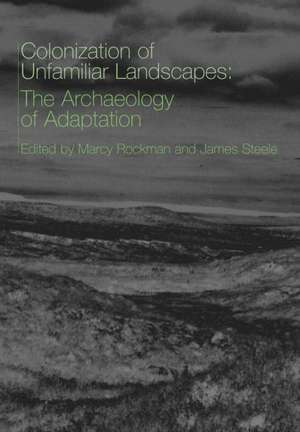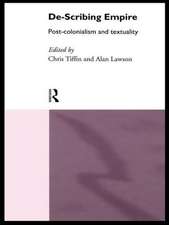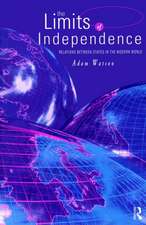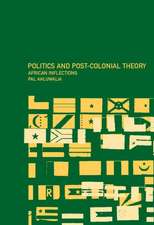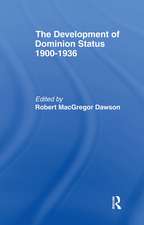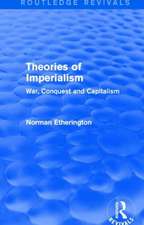The Colonization of Unfamiliar Landscapes: The Archaeology of Adaptation
Editat de Marcy Rockman, James Steeleen Limba Engleză Paperback – 10 apr 2003
A series of case studies examines the archaeological evidence for and interpretations of landscape learning from the movement of the first pre-modern humans into Europe, peoplings of the Old and New World at the end of the Ice Age, and colonization of the Pacific, to the English colonists at Jamestown.
The final chapters summarize the implications of the landscape learning idea for our understanding of human history and set out a framework for future research.
| Toate formatele și edițiile | Preț | Express |
|---|---|---|
| Paperback (1) | 369.73 lei 6-8 săpt. | |
| Taylor & Francis – 10 apr 2003 | 369.73 lei 6-8 săpt. | |
| Hardback (1) | 1004.20 lei 6-8 săpt. | |
| Taylor & Francis – 17 apr 2003 | 1004.20 lei 6-8 săpt. |
Preț: 369.73 lei
Nou
Puncte Express: 555
Preț estimativ în valută:
70.75€ • 73.72$ • 58.58£
70.75€ • 73.72$ • 58.58£
Carte tipărită la comandă
Livrare economică 03-17 aprilie
Preluare comenzi: 021 569.72.76
Specificații
ISBN-13: 9780415256070
ISBN-10: 0415256070
Pagini: 276
Dimensiuni: 152 x 229 x 12 mm
Greutate: 0.45 kg
Ediția:1
Editura: Taylor & Francis
Colecția Routledge
Locul publicării:Oxford, United Kingdom
ISBN-10: 0415256070
Pagini: 276
Dimensiuni: 152 x 229 x 12 mm
Greutate: 0.45 kg
Ediția:1
Editura: Taylor & Francis
Colecția Routledge
Locul publicării:Oxford, United Kingdom
Public țintă
UndergraduateCuprins
List of Tables and Figures List of Contributors Foreword Acknowledgements Editors' Introduction Section One: Conceptual Frameworks 1. Knowledge and Learning in the Archaeology of Colonization 2. Human Wayfinding Behaviour 3. Colonization of New Land by Hunter-Gatherers: Expectations and Implications Based on Ethnographic Data 4. Tracking the Role of Pathways in the Evolution of a Human Landscape: the St. Croix Riverway in Ethnohistorical Perspective 5. Mining Rushes and Landscape Learning in the Modern World Section 2: Case Studies 6. Landscape Learning and the Earliest Peopling of Europe 7. The Social Context of Landscape Learning and the Lateglacial - Early Postglacial Recolonization of the British Isles 8. "Where Do We Go From Here?": Modelling the Decision-Making Process During Exploratory Dispersal 9. Deerslayers, Pathfinders and Icemen: Origins of the European Neolithic as Seen from the Frontier 10. Entering Uncharted Waters: Models of Initial Colonization in Polynesia 11. The Weather is Fine: Wish You Were Here, Because I'm the Last One Alive: 'Learning' the Environment in the English New World Colonies Section 3: Advances in Theory and Method 12. Colonizing New Landscapes: Archaeological Detectability of the First Phase 13. Lessons in Landscape Learning Index
Notă biografică
Marcy Rockman is a Lecturer in the Department of Anthropology at the University of Arizona, Tucson. James Steele is a Lecturer in the Department of Archaeology at Southampton University.
Recenzii
'A very welcome addition to a respectable field.' - Cambridge Archaeological Journal
"...this book makes important contributions to the continuing study of landscape, and the bridging interdisiplinary gaps between archaeology and anthropology." Joost Fontein, University of Edinburgh
'Excellent ... Marcy Rockman and James Steele have done a good job.' - Landscape History
"...this book makes important contributions to the continuing study of landscape, and the bridging interdisiplinary gaps between archaeology and anthropology." Joost Fontein, University of Edinburgh
"...this book makes important contributions to the continuing study of landscape, and the bridging interdisiplinary gaps between archaeology and anthropology." Joost Fontein, University of Edinburgh
'Excellent ... Marcy Rockman and James Steele have done a good job.' - Landscape History
"...this book makes important contributions to the continuing study of landscape, and the bridging interdisiplinary gaps between archaeology and anthropology." Joost Fontein, University of Edinburgh
Descriere
A series of case studies examines the archaeological evidence for and interpretations of landscape learning from the movement of the first pre-modern humans into Europe to the English colonists at Jamestown.
